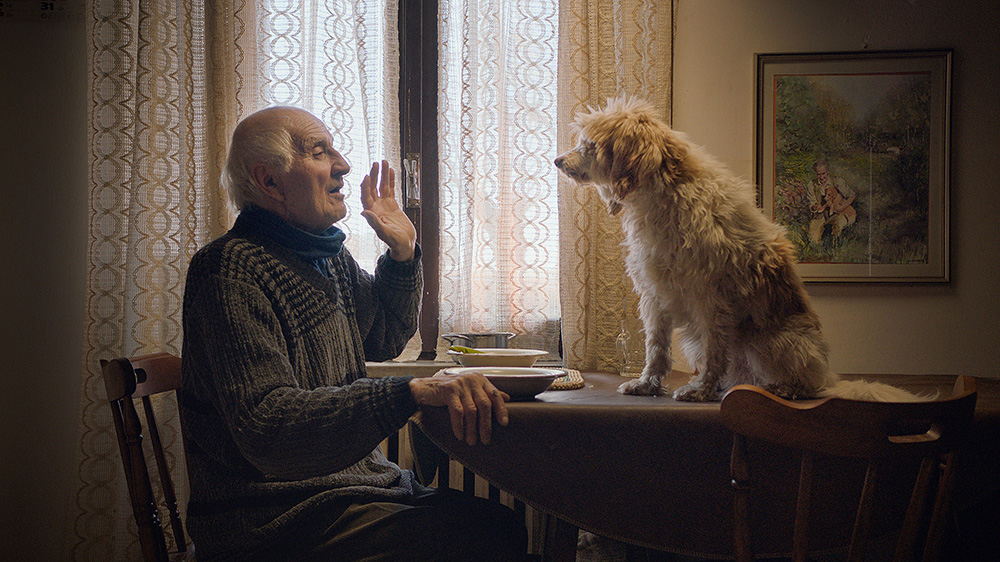Now I’ll rest and drink some wine.
There are few better examples depicting the erosion of human civility at the hands of capitalism than the continuous comparison being made between two generations of men in Piedmont, Italy throughout Michael Dweck and Gregory Kershaw‘s documentary The Truffle Hunters. One is represented by the aging hunters accustomed to old ways of decency and respect like Aurelio Conterno: a man who tells a meal partner that he plans to die without divulging his best locations for white Alba truffles. Gianfranco Curti epitomizes the other: a seller who took over the business his father ran in large part by buying the rare fungi Conterno and his contemporaries found in the wild. The former sect does it for the joy of the hunt, the latter merely for profit.
You can’t therefore blame Angelo Gagliardi for wanting to quit or Sergio Cauda lamenting the loss of his dog—the stalwart sniffing companions they and Carlo Gonella treat as equals insofar as their role in the hunt and their place in their hearts as veritable children. What once was an occupation of honor amongst friends enjoying the beautiful landscapes caught on-screen has been usurped by greed to the point where Curti marks-up truffles well past what he pays his suppliers and a recent influx of cutthroats trespassing on private land and planting poison to kill competing canines. As supply dwindles due to global warming, demand rises to bloodlust levels. So Conterno shouldn’t tell anyone secrets he cultivated over decades of hard work. These newcomers don’t deserve to know.

While this dynamic is a huge part of the story Dweck and Kershaw have curated, however, the film ultimately sets itself up as a joyous affair honoring these men and the culture they can’t quite leave behind. Carlo can barely see in the dark and yet he sneaks out a window so his wife Maria Cicciù doesn’t realize he’s ignoring his promise to only hunt during the day (she’d rather him stop altogether due to his pension). Cauda affixes a Go-Pro camera onto one of his dogs so that we can step into its singular viewpoint running through the forest with nose in overdrive. And Conterno is captured in his home conversing with fluffy little Birba and stealing kisses from the pet by placing meat between his lips.
They love the excuse to breathe fresh air and play with their animals. They even love to simply smell truffles, always asking neighbors for a whiff of whatever they found whether a handful or one solitary tuber. And they aren’t afraid to show their disdain for the malicious opportunists and thieves entering their word for a quick buck because men like Paolo Stacchini crave a shredded truffle on their fried egg breakfasts at swanky restaurants—the economic divide between those who pay exorbitant prices and those digging in the dirt a glaring example of our planet’s growing wealth disparity off the backs of exploited workers. To hear Curti lament that he works too hard to eat “his” product will make you want to punch him in the face.
That Dweck and Kershaw captured the footage they have of Stacchini and Curti proves how those men don’t care about the optics of their roles in this industry. Put it in context with the rest, however, and it’s too damning to ignore. I wonder if Gagliardi has thus written a follow-up letter about hunting’s downfall after seeing the final cut of the film since it’s one thing to tell Curti to get off his property and another to witness just how poorly he treats the hunters who are still willing to sell him their finds. It’s hard not to let that vitriol rise higher than the excitable memories of past exploits and dogs since nostalgia only gets you so far when present-day reality actively works to erase it.

Putting both side by side is what makes The Truffle Hunters such an intriguing document, though. Rather than be a puff piece of old men doing what they love or a scathing exposé of capitalist profiteering, the filmmakers are able to provide a three-dimensional look at Piedmont’s niche economy through their subjective compiling of objective vignettes. They are observing authentic moments of conflict, remembrance, and adventure that say so much more when presented in tandem than they ever could alone. It’s a delicate balance that never risks going too far in one direction at the detriment of the other. Having such colorfully endearing characters to use as subjects definitely helps. They each wear their personalities unapologetically on their sleeves—for better or worse—to entertain, educate, and inspire.
And if that isn’t enough, you have Dweck and Kershaw’s gorgeous cinematography rendering even the most innocuous settings into beautiful compositions. There’s humor with Cicciù yelling towards the vast fields for Carlo to return home before dark and an almost clandestine suspense when Curti shakes down hunters for truffles in darkened, moonlit streets. The dog’s eye sequences might cause some in the audience to get sick to their stomachs (especially when a full body shake occurs), but they never go so long that the welcome kinetic energy driving them wanes. The result is our transportation into an exotic world we’d never think to explore ourselves with remarkable tour guides from a bygone era who admirably refuse to sacrifice their traditions for the benefit of interlopers. Good for them.
photography:
[1] Left to Right: Aurelio Conterno, Birba (dog) in THE TRUFFLE HUNTERS Image by Michael Dweck and Gregory Kershaw. Courtesy Sony Pictures Classics
[2] Left to Right: Carlo Gonella, Maria Cicciù in THE TRUFFLE HUNTERS Image by Michael Dweck and Gregory Kershaw. Courtesy Sony Pictures Classics
[3] Center: Gianfranco Curti in THE TRUFFLE HUNTERS Image by Michael Dweck and Gregory Kershaw. Courtesy Sony Pictures Classics

